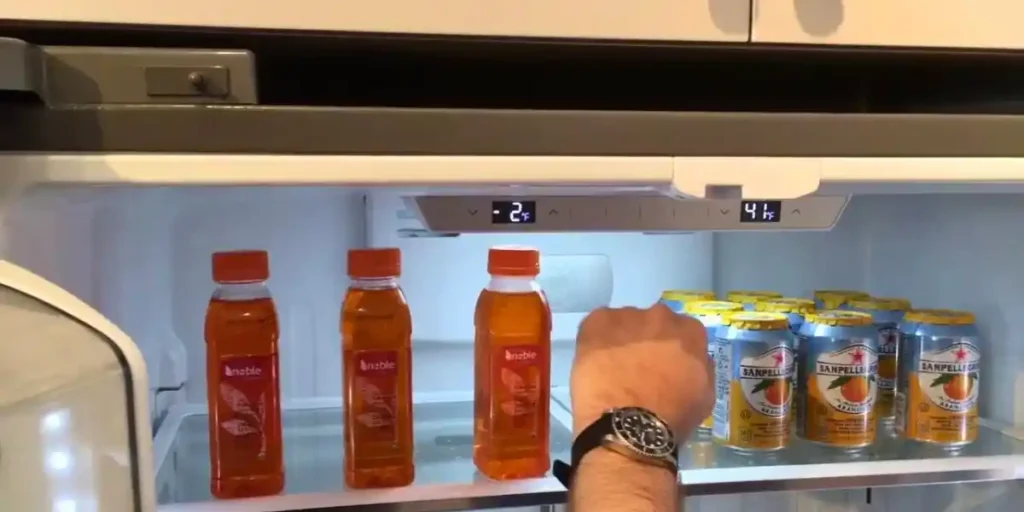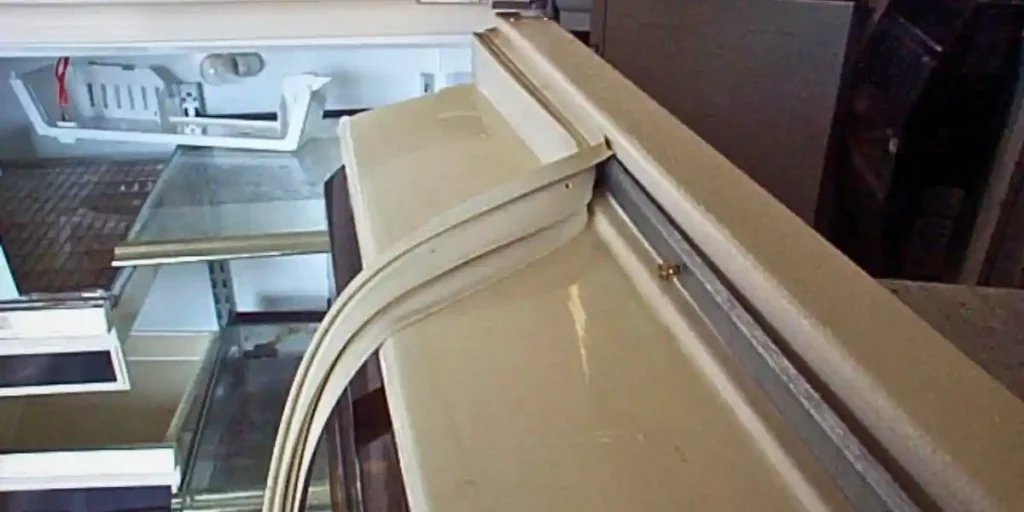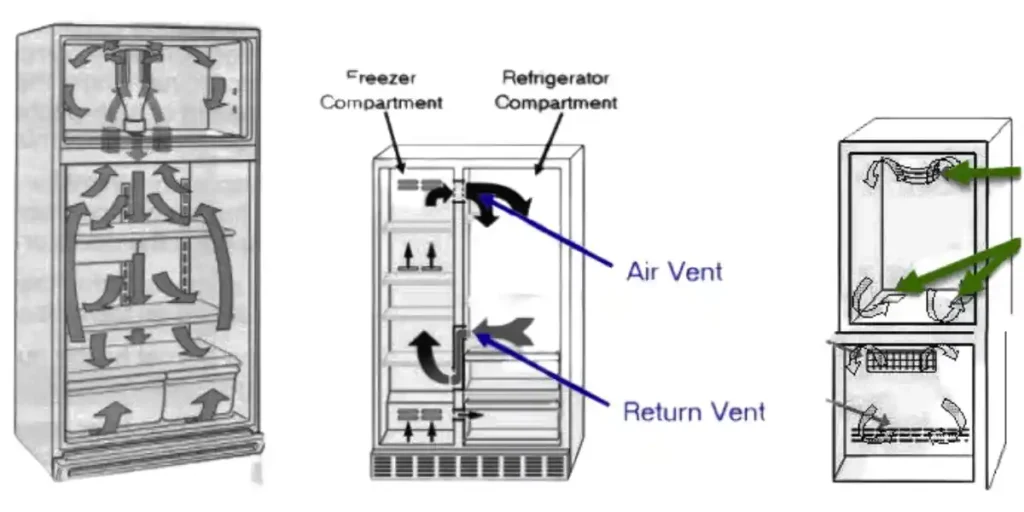Refrigerator Gets Warm Then Cold Again: Diagnose and Solve
We may earn affiliate fees for purchases using our links (at no additional cost to you).

If your refrigerator goes through cycles of getting warm and then cold again, it can be frustrating and concerning. Several factors can contribute to this issue.
Overfilling the refrigerator with food can make it difficult for the system to maintain a consistent temperature. Faulty evaporator coils or the evaporator fan can also cause temperature fluctuations.
A damage control board may disrupt the refrigerator’s internal temperature regulation. To fix this issue, try reducing the amount of food in the refrigerator, checking and cleaning the evaporator components, and ensuring the control board is functioning correctly.
Quick Overview of Reasons, Signs, and Solutions of Temperature Fluctuation in Refrigerators
| Reasons | Symptoms | Solutions |
| Door seal Issue | Worn out gasket | Replace the door seal |
| Dirty Coil | Dust on the coils | Clean the coil with a brush and vacuum |
| Malfunctioning Thermostat | The fridge won’t respond to the temperature change | Replace the thermostat |
| Incorrect settings | The fridge becomes over cool or undercool | Adjust the temperature |
| Airflow problems | Blocked vents | Clean the vents |
| Electrical issues | Blown fuse | Fix the electrical problem |
| Aged refrigerator | Worn out fridge | Replace the fridge |
Why Does a Refrigerator Get Warm Then Cold Again?
Your refrigerator might get warm and then cold again due to various factors such as malfunctioning components or incorrect settings. Understanding the basic refrigeration cycle can help us pinpoint the problem.
Understanding the Basic Refrigeration Cycle

The refrigeration cycle involves several key components:
The Compressor
This is the heart of your refrigerator. It compresses the refrigerant, turning it into a high-pressure gas. If it malfunctions, it can cause temperature fluctuations.
The Condenser Coils
These coils dissipate heat from the high-pressure gas, turning it into a high-pressure liquid. Dirty or damaged coils can lead to inconsistent cooling.
The Evaporator Coils
These coils absorb heat from inside the fridge, turning the refrigerant into a low-pressure gas. Issues here can cause your fridge to get warm.
The Thermostat
This device regulates the temperature inside your fridge. If it’s not working properly, your fridge might get warm and then cold again.
Common Causes for Temperature Fluctuation in Refrigerators

Door Seal Issues
The door seal, also known as a gasket, is crucial for keeping the cold air inside your fridge. If it’s damaged or worn out, warm air can sneak in. This forces your fridge to work harder, leading to temperature fluctuations.
Dirty Coils
Your fridge has two sets of coils: the condenser coils and the evaporator coils. If they’re covered in dust or grime, they won’t be able to transfer heat effectively. This inefficiency can lead to inconsistent temperatures.
Malfunctioning Thermostat
The thermostat is like the brain of your fridge. It controls when the compressor turns on and off based on the temperature inside the fridge. If it’s not working properly, it might not be able to maintain a consistent temperature.
Incorrect Settings
Sometimes, the issue might be as simple as having the temperature set too high or too low. Incorrect settings can cause your fridge to over-cool or undercool.
Airflow Problems
Your fridge needs good airflow to cool efficiently. If the vents are blocked or if there’s too much food crammed inside, it can disrupt airflow and cause temperature fluctuations.
Electrical Issues
Problems with your fridge’s electrical components can also cause temperature fluctuations. This could be anything from a blown fuse to a faulty start relay.
Age of the Refrigerator
Like any appliance, fridges can start to wear out over time. Older fridges are more likely to have issues with temperature regulation.
Diagnosing Process for Temperature Fluctuation in Refrigerators
Visual Inspection
Start by visually inspecting your refrigerator. Look for any obvious signs of damage or wear and tear. This includes checking the door seal for cracks or gaps, and ensuring the vents aren’t blocked by food items.
Check the Coils
The condenser coils and evaporator coils play a crucial role in your fridge’s cooling process. If they’re dirty, they won’t be able to transfer heat effectively, leading to temperature fluctuations. You can usually find these coils at the back of your fridge or underneath it.
Test the Thermostat
The thermostat controls the temperature inside your fridge. If it’s not working properly, it could be causing your fridge to get warm and then cold again. To test it, adjust the temperature setting and see if the fridge responds accordingly.
Check the Settings
Sometimes, the issue might be as simple as having the temperature set too high or too low. Check your fridge’s manual to find out what the ideal temperature setting is.
Listen for Unusual Noises
Unusual noises can be a sign of a malfunctioning component. For example, if you hear a clicking sound, it could indicate a problem with the start relay.
Monitor Temperature Changes
Keep an eye on your fridge’s temperature over some time. If it’s constantly fluctuating, it could indicate a more serious issue.
Solutions and Quick Fixes for Temperature Fluctuation in Refrigerators
Door Seal Issues

If the door seal is damaged or worn out, it needs to be replaced. You can purchase a new seal from an appliance parts store or online. Make sure to get the correct size for your fridge model.
Dirty Coils
If the coils are dirty, they can be cleaned using a coil brush or a vacuum with a brush attachment. Be sure to unplug your fridge before cleaning the coils.
Malfunctioning Thermostat
If the thermostat is not working properly, it may need to be replaced. This is a more complex task that might require a professional.
Incorrect Settings
Check your fridge’s manual to find out what the ideal temperature setting is. Adjust the temperature settings if necessary.
Airflow Problems

Make sure the vents in your fridge are not blocked by food items. Rearrange items if necessary to improve airflow.
Electrical Issues
If you suspect an electrical issue, it’s best to call a professional. Electrical repairs can be dangerous if not done correctly.
Age of the Refrigerator
If your fridge is old and frequently has issues, it might be more cost-effective to replace it with a new, more energy-efficient model.
How Does Putting a Refrigerator in Defrost Mode Help Solve Warm/Cold Cycling Issues?
Putting a refrigerator in defrost mode is a crucial step to tackle warm/cold cycling issues. The Refrigerator Defrost Mode prevents ice buildup on the evaporator coils, which can cause poor cooling performance and inconsistent temperature fluctuations. This mode allows the coils to thaw, ensuring efficient operation and preventing frequent temperature imbalances within the fridge.
Environmental and Economic Impact on Temperature Fluctuation in Refrigerators
The Role of Refrigerants in Temperature Fluctuation
Refrigerators and air conditioning units contain chemicals that readily absorb heat from the environment as they transition from a cool liquid into a gas.
As they transition back to liquid, they release the heat into the outside. This cycle is crucial for maintaining the temperature inside the refrigerator.
The Environmental Impact of Refrigerants
Refrigerants are incredibly polluting, accounting for around 10% of global CO2 emissions. That’s three times the amount produced by aviation and shipping combined.
Moreover, emissions from leaking refrigerants directly affect the climate and are 600-3800 times worse than CO2.
The Economic Impact of Temperature Fluctuation
Temperature fluctuation in the food cold chain is becoming an increasingly crucial factor in the process of food production and for the logistic business.
The quality of perishable food products depends largely on accurate transport and maintenance temperature.
The Future of Refrigeration Technology
With countries and companies under pressure to slash their contribution to climate change, the cooling industry is facing a radical overhaul to the way it produces and disposes of refrigerants.
Over the past three decades, governments around the world have pledged to crack down on potent climate-warming chemicals used as coolants.
FAQ About Refrigerator Temperature Fluctuations
What is the optimal temperature for a refrigerator?
Is it normal for a refrigerator to cycle on and off?
How often should I clean the condenser coils?
Is my food blocking the air vents, causing temperature fluctuations?
Conclusion
Don’t sweat it if your refrigerator gets warm and then cold again; you’re not alone in facing this issue. Check thermostat settings, ensure door seals are snug, and keep those condenser coils clean.
Still puzzled? A malfunctioning component might be the culprit, so don’t hesitate to call a pro for a quick fix.
